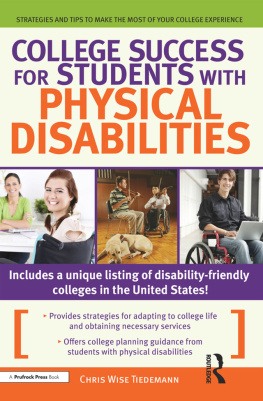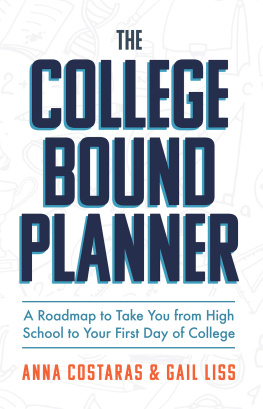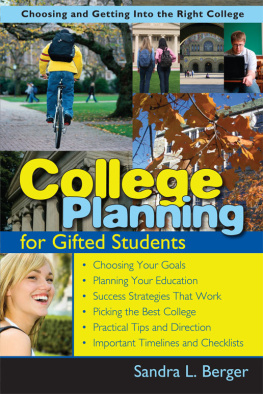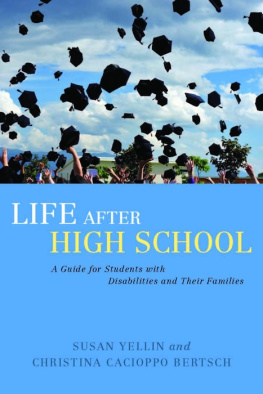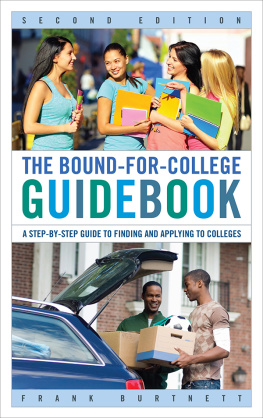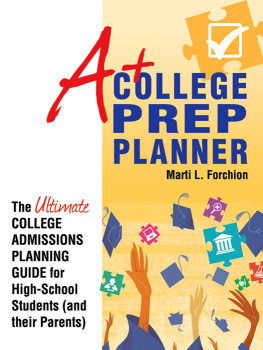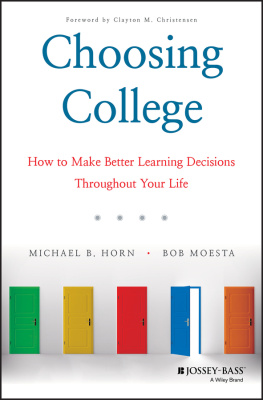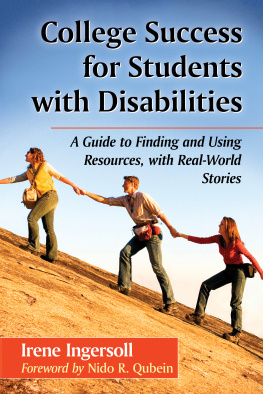Elizabeth C. Hamblet splits her time between working with students as a college learning disabilities specialist and educating parents and professionals about how to prepare students with disabilities for successful college transition. She is author of two previous book editions, two brief guides, and numerous articles on this topic, and she gives presentations on transition around the country. Hamblet has been a columnist for Disability Compliance for Higher Education since 2009.
I am so grateful to everyone who helped me with this new edition.
Id like to thank Tom Koerner at Rowman & Littlefield and my agent, Grace Freedson, for seeing the potential in this book, and the Rowman & Littlefield team for making it a reality.
If you find this book to be fluid and well-organized, you can join me in thanking Ross J. Q. Owens, my editor, for his guidance and feedback.
Jamie Axelod has been an incredibly helpful mentor and teacher. His advice has been invaluable, and his generosity with his time and knowledge has been an enormous gift.
I want to thank Meg Grigal, Laura Kazan, Jill Jansen, Leena Landmark, Elena Silva, and Pete Wright for educating me and making sure I didnt misinform readers.
And I want to thank all of the folks who shared their knowledge and expertise to make sure students with disabilities have the preparation they need for a bright future, whatever path they decide to take. They were chosen because of their knowledge and their passion for helping students. They are:
Deborah S. Braswell
Jane Thierfeld Brown
Margaret Camp
Joan K. Casey
Rick Clark
Elizabeth Cooper
Leann DiAndreth-Elkins
Laura DiGalbo
Eric Endlich
Catherine Getchell
Paul Harwell
Ann Knettler
Mike Langford
Sherri Maxman
Gabrielle Miller
Gregory Moyer
Doris Pierce
Jeremiah Quinlan
Stacey Reycraft
Jane Sarouhan
Jason Sarouhan
Keyana Scales
Spencer Scruggs
Korey Singleton
Sacha Thieme
Eric Trekell
Annie Tulkin
Scott van Loo
Jennifer Walker
Imy Wax
Jorja Weybrandt
Belinda Wilkerson
Marvin Williams
Lorraine Wolf
Finally, and as always, I want to thank my husband, who isquite simplythe best.
Given all of the points of law that address students with disabilities (see ), what really happens at college? Understanding the changes in the laws is vital, but its only part of the picture.
The best way to get a sense of how things play out is through research conducted at a national level. The National Longitudinal Transition Study (NLTS) has collected data over three different time periods, beginning in the 1980s, to help in developing an understanding of the experiences of secondary school students with disabilities nationally as they go through their early adult years. As part of the study, data was collected from those students in each cohort who attended postsecondary schools (meaning they continued their education after high school).
At the time of this writing, some reports have been published using the data from the NLTS2012. But none has provided the kind of overview on college enrollment and accommodation use that is available from the NLTS2. For that reason, the data from the NLTS will be discussed here.
The NLTS2 followed a nationally representative sample of students who were 13 to 16 years old and receiving special education in grade 7 or above, under the Individuals with Disabilities Education Act (IDEA) in the 200001 school year.
The last data collection was done in 2009. Some of the language used to describe disability categories may seem outdated and insensitive; it is included in the tables here because thats how it appeared in some of the write-ups. Even though the data is outdated, because of the studys size, it can provide some helpful insight about the experiences of students.
College Enrollment
Over the course of the NLTS2, 60.1 percent of students in the cohort had ever enrolled at any kind of postsecondary school.
In their analysis of the NLTS2 enrollment data, Newman et al. found that of the students who attended any kind of postsecondary education:
- 44.2 percent of students with disabilities enrolled at a two-year or community college compared to 20.6 percent in the general population
- 32.3 percent of students with disabilities enrolled at a career and technical education (CTE) school compared to 20.3 percent in the general population
- 18.8 percent of students with disabilities enrolled at a four-year school compared to 40.2 percent in the general population
Newman and Madaus explained that in their analysis of the NLTS2 data, students who attended more than one kind of college were included only once in the overall enrollment number calculated (51 percent), but they may have been counted twice in the enrollment rates for different kinds of schools (36 percent for two-year schools, 23 percent for CTE schools, and 15 percent for four-year schools). This may explain why their overall number for enrollment doesnt align with Newman et al.s figures.
Students with learning disabilities were by far the largest part of the NLTS2 cohort that attended any kind of postsecondary education. Prevalence rates were:
- 69 percentlearning disabilities
- 9 percentstudents with emotional disturbances (that is the wording used in the study)
- 6 percentintellectual disabilities
- 5 percentother health impairments (students with ADHD are included in this federal disability category)
- 5 percentspeech/language impairments
The remaining 6 percent of the cohort comprised students in other disability categories (hearing impairment, visual impairment, orthopedic impairment, autism, traumatic brain injury, and deaf-blindness); the researchers didnt provide further breakdown of that number. Thirty-six percent of students had ADHD in addition to another disability.
Receiving Accommodations at College
Even though 98 percent of students in the NLTS2 had had at least one accommodation in high school, only 24 percent did at the postsecondary level. Looking at different school types, the rate of receipt was:
- 25 percent of students enrolled at a two-year college
- 22 percent of those enrolled at a four-year college
- 16 percent of those enrolled at a CTE school
A separate analysis found that of this cohort, those with disabilities that were apparent (meaning visible), including those with hearing impairments or orthopedic impairments, were more likely to receive accommodations and other disability-related services at two-year and four-year colleges than students with learning disabilities, even though students with learning disabilities made up the majority of students with disabilities at each type of school. At four-year schools, though, students with ADHD were more likely than students with other disabilities to receive accommodations and services. And at CTE schools, students with autism were more likely to receive accommodations than any other group.
Potential Explanations for Lower Rates of Accommodation at the College Level
Why was there such a drop in the number of students who received accommodations in high school versus those who receive them in college? As already noted, students with disabilities who wish to receive accommodations typically have to register with their colleges disability services office. This means students have to make a deliberate decision to follow their colleges process for registering. It seems likely that they would be motivated to do this by a sense that they would benefit from accommodations.


